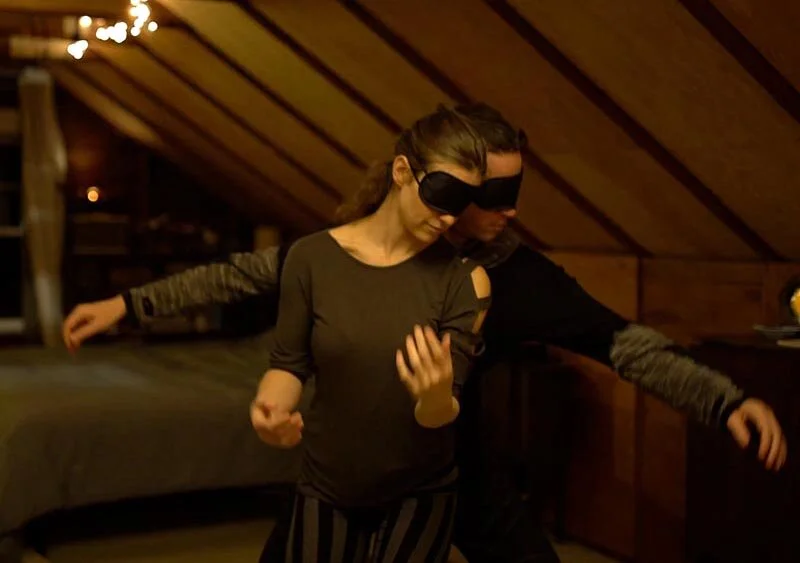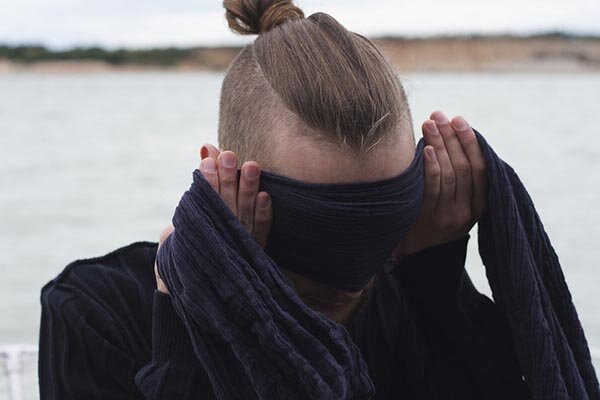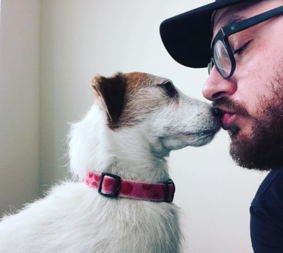The Benefits of Blindfolded Couples Dancing
A different way of connecting with your lover that’s not as hard to do as you’d think.
By Jessie Schiewe
Candice Holdorf and Gabriel Diamond have been teaching blindfolded dancing in the San Francisco Bay Area since 2017. (Photo: Gabriel Diamond)
People have a thing about associating blindfolds with sex.
“Many folks get all giggly and weird when you talk about it,” Candice Holdorf, a writer and embodiment coach in the San Francisco Bay Area, told OK Whatever.
The issue, she thinks, is that people mistake the sensual aspects of using blindfolds as being sexual in nature.
But that’s not quite the right way to look at it. Wearing a blindfold is an inherently sensual experience because it heightens our other senses. The sexual part is something an individual chooses to introduce on their own.
In reality, there are numerous scenarios where blindfolds can be used in decidedly un-kinky contexts.
At birthday parties, kids pin tails on cardboard donkeys while wearing blindfolds.
Magicians might wear them during knife-throwing stunts.
In bedrooms, people snooze with them on, in the form of sleeping masks.
During meditation retreats, they can deepen one’s practice and quiet the mind.
For elaborate reveals, such as gifting someone a new car or showing off a completed home remodeling, blindfolds can heighten the moment even more.
Wearing a blindfold doesn’t always mean something sexy is about to go down. (Flickr/Blind Fields)
There are also speed-dating parties where singles wear blindfolds so that they can meet prospective partners sans judgements or personal biases.
Blindfolds might even show up as props in corporate team-building events, helping employees build trust and forge alliances with each other.
They’re “tools for personal growth,” Holdorf explained, “whether that’s in the boardroom, the dance room, or the bedroom.”
Blindfolds are also easier to navigate around in than you might think, she said.
“We underestimate our other senses. You’re more capable of sensing and navigating the world than you might think.”
In 2018, Diamond wore a blindfold on a street corner in Berkeley, Calif., and invited strangers to join him in dancing. (Mar al'Dao)
Except for in a few situations (say, if you’re bashing a piñata to release its candy), wearing a blindfold can have a slowing-down effect on a person, both in thought and movement.
“This might sound a little woo-woo maybe, but actually the blindfold enhances your attunement with yourself and with others,” explained Gabriel Diamond, a Bay Area-based filmmaker who is also Holdorf’s partner. “There’s this non-verbal, non-visual tuning in that happens.”
When it comes to blindfolds, Holdorf and Diamond know what they’re talking about.
For the last couple of years, the couple has delved deep into the world of blindfolded dancing, experiencing first hand the profound and transformative effects that obliterating visual stimuli can have when combined with movement and freedom of expression.
Since 2017, they’ve also been teaching Blindfolded Contact Dance workshops so that others can learn how to similarly “let go” through movement in safe, supportive environments.
Blindfolded dancing itself is not hard, but it does have a learning curve. You’re not busting moves or striking poses. There’s no twerking or shopping cart pushing going on, either.
“Over and over in our classes, we hear people say: ‘I fell in love with the whole room.’ ” (Ben Lazar)
Everything that is performative about dance gets plucked out once you place that eye covering on. You move slower and more gracefully, interacting with your fellow blindfolded dancers in the most subtle and gentle of ways. Maybe you’ll feel someone’s fingers flutter across your back or find yourself dancing forearm-to-forearm with another person.
“No one has to worry about how they look. They can just focus on what feels good and what movements want to arise from within,” Diamond said.
“It’s a chance to de-armor ourselves,” Holdorf added, “to reconnect to our common humanity.”
The pair usually teaches their Blindfolded Contact Dance lessons in group settings, to anywhere from a few dozen people to more than 100 at one time.
But they also stress that it’s something you can practice on your own, or, better yet, as a couple.
Crawling and rolling are common moves in blindfolded dancing, which is why when standing, you should take short, shuffling steps. (Gabriel Diamond)
Especially with Valentine’s Day around the corner, now might be a great time in particular to play around with this artistic exercise, especially as a means of increasing intimacy with a partner. Holdorf and Diamond created a short instructional video geared specifically for couples interested in trying out blindfolded dance at home.
“This guide can be used for long-term partners, first dates, Valentine’s Day, platonic connections — anytime you want to spice up your relationship and build trust,” they wrote in the video’s description.
Intrigued but need more convincing? Here are five reasons why blindfolded dancing with your partner might just be the glue your relationship has been missing.
Blinfolded dance can spice up your love-life
Holdorf: In the BDSM world, blindfolds are huge. It’s a type of power-dynamic play that can help you find an erotic sense of self through absolutely surrendering yourself and trusting another person to take you through an experience.
It can restore eroticism to your relationship, too. Trusting and surrendering to your partner fully can be incredibly hot.
It can make you more comfortable with your partner
Diamond: So often in life, we are in our heads. The blindfolds are shortcuts to put us into our bodies.
When you are in your body with your partner in a similar state, it can create new levels of intimacy and connection that bring that quality of novelty and newness that so many long-term partnerships crave.
Holdorf and Diamond have taught blindfolded dancing workshops at the Ecstatic Dance Campout and at SoulPlay Festival. (Rachel Ratliff)
It can be used instead of fighting or arguing
H: There have been times in my relationships when we’ve become so tired of processing or talking about the relationship. What’s needed in those times is not more words, but more movement; moving our way through healing while in connection, rather than spending another hour talking about what went wrong, how I was hurt, etc.
It’s not that processing is a bad thing. It’s important to be able to speak clearly and vulnerably about your feelings in a relationship. But it can start to feel like navel-gazing after a while, which is why moving stuck energy through movement can also be used as a potent way to reset with your beloved.
It can help you learn more about your partner’s turn-ons and turn-offs
H: Blindfolded dance often requires you to learn how to attune — or listen through your body — to your partner. You can feel them more — not just physically, but also emotionally, and energetically. And, you can feel more easily when something is “off” and when something is “on.”
D: When you put a blindfold on, it’s like everything else is heightened. You’re able to let go of your biases and prejudices and to instead use the evidence that can actually be sensed.
Sometimes the things that seem the most scary or weird are what we need most. (Ben Lazar)
You can learn more about yourself, too
H: Sometimes, an intention I like to play with is: “Dance with yourself the way you would like your beloved to dance with you.”
When I hold this intention, I stop grasping for another person and learn more about the kinds of touch I actually enjoy. I can generate my own pleasure in the dance and stop worrying about looking good or pleasing people. I learn to love myself exactly as I am. I learn what I like and don’t like. I learn more about my boundaries.
And, knowing these aspects of yourself will only strengthen your ability to show up as a supportive partner.














